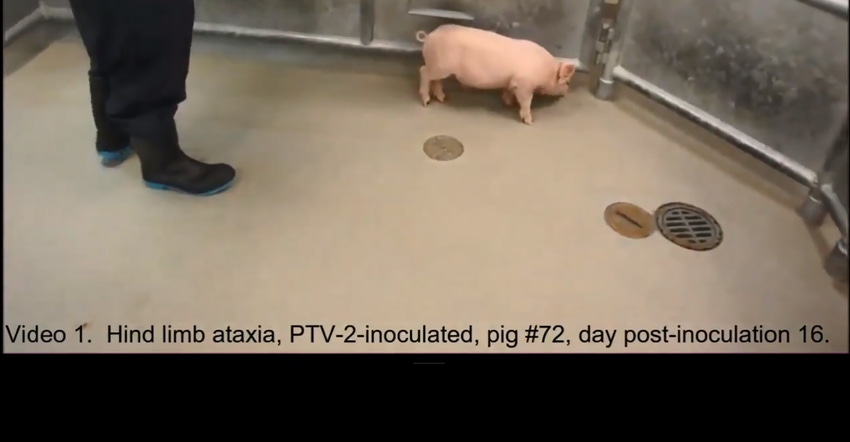Webinar sponsored by SHIC and AASV provides resources.
December 6, 2019

To properly treat diseases in your swine herd, it is important to get an appropriate and accurate diagnosis, as symptoms of various diseases can be similar.
Such is the case with central nervous system diseases, and veterinarians and producers heard from five experts during a webinar "Disease Management of Viral Myelitis" earlier this week. This webinar, that took place Wednesday, presented information by diagnosticians as well as case studies providing insight into symptoms of these central nervous system diseases, appropriate steps for diagnosis, as well as on-farm management experience with porcine astrovirus 3, porcine sapelovirus and porcine teschovirus. A recorded version of the webinar, sponsored by the Swine Health Information Center and the American Association of Swine Veterinarians, can be viewed by clicking here.
Matthew Sturos, University of Minnesota Department of Veterinary Population Medicine, notes symptoms of CNS disease include incoordination/ataxia, weakness, head tilt, inappropriate mentation, circling, blindness, knuckling, tremors, paddling, paresis and convulsions. Each of these symptoms has a root cause from differing segments of the CNS: brain, vestibular or cervical.
An appropriate diagnosis is important because other causes of similar symptoms can be the result of non-spinal diseases. Diagnostic assays for viral myelitides require fresh tissues for testing and analysis. During the webinar, Sturos details the appropriate sampling options for accurate diagnoses. In addition to the processes for sample collection, he also says it will help the pathologist when information included with the submission includes the CNS signs. He also recommends submission of non-CNS tissues for the best testing protocol and results.
Bailey Arruda, Iowa State University Veterinary Diagnostic Lab, further emphasizes the necessity of aseptic collection. She also describes the necessity of choosing the right pigs for tissue collection, noting disease progression will impact the accuracy of analysis.
With PSV and PTV, Arruda notes affected herds have pigs from 4 to 16 weeks old impacted with a case fatality rate of 90% to 100%. The typical disease duration is less than four days in individual pigs, weeks to months in a group of pigs, and months to years in intergroup settings. PoAstV3 has been diagnosed around the world with five lineages identified. Pigs from 20 days of age through sows are impacted when infection is present. There is a case fatality rate of 90% to 100%. Treatment has been unrewarding.
Arruda says fecal shedding of all three viruses is common. She also says development of CNS disease is relatively uncommon, pointing to risk factors for infection of co-infections, genetics, immune response and maternal immunity as well as diet and microbiota.
In addition to the technical information provided by Sturos and Arruda, three swine practitioners share their experience with CNS diseases. Grant Allison, Walcott (Iowa) Veterinary Clinic, describes a client's PoAstV3 infection. Pete Thomas, Iowa Select Farms, explains how they managed a PTV diagnosis. And Aaron Lower, Carthage (Illinois) Veterinary Service, details their clients' PSV experience.
These case studies illuminated the realities on the farm including diagnosis, recovery, treatments and learning.
Arruda concludes the webinar by exploring scientific design to test management options. She says an evidence-based approach is necessary. "We need more information to make decisions for defensing versus reacting," she remarks. The goal is better understanding of the viruses, hosts and environment. With her proposed design for exploring CNS, the importance of maternal immunity, herd and individual impact, co-infection and/or prior infection role in severity, along with determining other risk factors could help predict infections.
Funded by America's pork producers to protect and enhance the health of the U.S. swine herd, the Swine Health Information Center focuses its efforts on prevention, preparedness and response. For more information, visit the SHIC website or contact SHIC Executive Director Paul Sundberg.
Source: Swine Health Information Center, which is solely responsible for the information provided, and wholly owns the information. Informa Business Media and all its subsidiaries are not responsible for any of the content contained in this information asset.
You May Also Like



